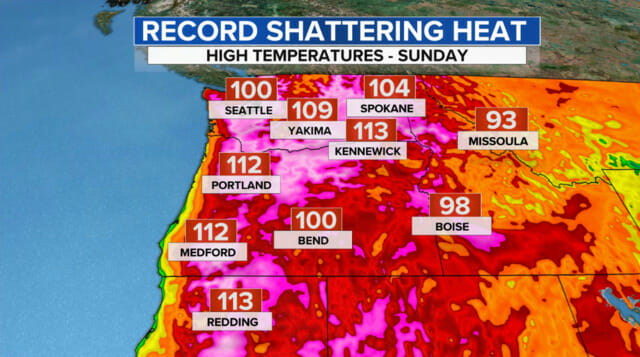
AZ Heat Resilience Workgroup working to address extreme heat
Extreme heat is often thought of in conjunction with Arizona, but other states are also experiencing unprecedented higher temperatures during a heat wave in the Pacific Northwest.
“Heat is a multifaceted problem and solutions require a lot of different pieces from a lot of different people and programs,” said David Hondula, associate professor at ASU’s School of Geographical Sciences and Urban Planning . “We have the opportunity in our state to set international best practices about how to thrive in the face of extreme heat and other sustainability challenges but must be working together to do so.”
In Portland, Oregon, temperatures reached an astounding 116° on June 28th, breaking the previous record of 107°, a temperature last reached in 1981 and 1965. For reference, the average daily high in Portland on June 28th is 77° – which means the temperatures reached last week were nearly 40° above average. As a result of the heat wave, Portland saw 63 heat-related deaths in less than a one-week span. Seattle, Washington also saw record-breaking temperatures, reaching 114° on June 27th, as did Lytton, British Columbia, which reached 121° on June 29th. The National Weather Service called the heat wave “historic, dangerous, prolonged and unprecedented.”
Arizona experienced a heat wave two weeks prior to the one currently baking the Pacific Northwest. During the week of June 12-19, temperatures reached 118°. Maricopa County is currently investigating 53 deaths that occurred the week of the heat wave. In 2020, Arizona experienced 323 heat-related deaths, which is 62% higher than in 2019. This is the highest number on record since the Maricopa County Department of Public Health started tracking heat deaths in 2001.
“Mortality and morbidity from extreme heat is preventable,” said Melissa Guardaro, an assistant research professor at ASU with Healthy Urban Environments (HUE) and Knowledge Exchange for Resilience (KER). “We must work together to not only prevent heat illness and deaths but to provide greater thermal comfort to all of our residents.”
Extreme heat is an immediate threat and ASU’s Arizona Heat Resilience Workgroup is meeting every two weeks during the summer months in order to respond at the highest capacity. The co-hosted SCN and HUE Workgroup was created in the spring of 2020 in anticipation of the extreme summer heat and the potential increased vulnerability of the public due to COVID-19. The workgroup’s purpose is to actively convene cities, counties, state agencies, non-profit organizations, service providers and other stakeholder organizations from around Arizona to monitor heat forecasts and warnings from National Weather Service, share best practices relating to heat response and relief, and to encourage collaboration, coordination, and development of novel responses to preparedness and resilience to extreme heat. The workgroup is always looking for more participants at both the municipal and non-profit sectors. If you are interested in joining, you can fill out the Workgroup Participation form here.
“We are over 100 years into how we regulate, finance, insure and govern flooding in the US,” said Braden Kay, Sustainability Director for the City of Tempe. “We are about five years into our collective journey in extreme heat governance. We have a long way to go but coordination like this is promising.”
The workgroup has grown in participation over the past year, particularly with the addition of the Cooling Center Subgroup. This subgroup works with the Maricopa Association of Governments, as well as 2-1-1 Arizona, an informational and referral live-operator service that operates 24 hours a day, 365 days a year, to relay heat-related information to the public. The subgroup has also collaborated with the Arizona Faith Network to increase the number of cooling center locations available this summer.
Vulnerable populations including the elderly, the unsheltered, communities of color and those in low-income areas are particularly effected by extreme heat. Cooling centers are a particular focus as they provide immediate relief and support to those experiencing extreme heat.
“The workgroup focuses on vulnerable populations and their needs. The group has addressed coordination of services, such as utility assistance, heat relief network improvements, and communications specifically targeted to at risk populations,” said Guardaro.
The workgroup will have the opportunity to attend a National Oceanic and Atmospheric Administration round table to provide feedback on consistent distribution on heat and weather information. In addition to this federal recognition, ASU researchers and members of the workgroup are also publishing important heat-related research. ASU researcher Jenni Vanos’ work on heat and the effect on people was recently highlighted in an article, “Models of human heat strain don’t account for complexities.” The AZ Heat Resilience Workgroup, along with the heat-related research, articles, and federal recognition, are all important contributions towards creating a safer and healthier climate.
“Our work group is just one milestone in the marathon of creating a sophisticated and effective approach to managing extreme heat in our state,” said Kay.
The ASU Sustainable Cities Network (SCN) is an innovative education and outreach program within the Julie Ann Wrigley Global Future Laboratory, created to work with communities to strengthen sustainability in the region and across Arizona. Comprised of Arizona city, town, county and tribal community practitioners and leaders, SCN is a vehicle for sharing knowledge, identifying best practices, coordinating planning and actions, and fostering long-term partnerships. Created as a bridge between ASU research and local sustainability challenges, SCN participants and partners work together to streamline and green city operation and advance local and regional sustainability and resilience measures.